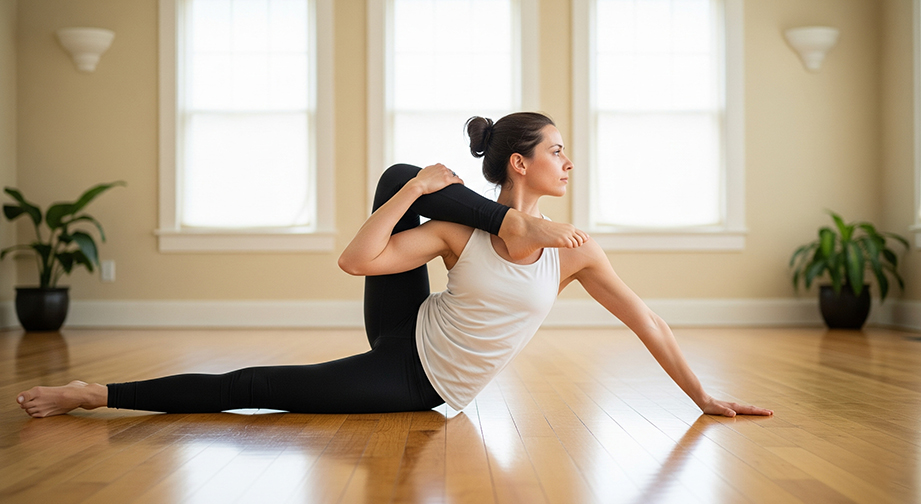Bhairavasana (Ankushasana) - Formidable Pose (Reclining): Step-by-Step Yoga Guide
Introduction
Bhairavasana, also known as Ankushasana or the Formidable Pose (Reclining), may look intimidating at first, but under the guidance of proper steps, it can become an empowering addition to your practice.
In Sanskrit, "Bhairava" means "the formidable" or "a fierce manifestation of Shiva" – symbolizing power, focus, and presence. This posture embodies a sense of invigorating strength and openness.
Essence: Grounding, energizing, and confidence-boosting.
If you’ve ever wished for more freedom in your hips and hamstrings – or confidence in your practice – this pose can help you unlock both, step by step.
Step-by-Step Guide to Bhairavasana (Ankushasana)

- Start in Reclining Position:
Lie down comfortably on your back. Adjust your spine and feel grounded.
- Bend One Knee Up:
Keeping your left leg extended on the floor, bend your right knee and place your right foot outside your right hip.
- Lift and Place the Leg:
Using your right hand, gently draw your right knee in toward your right armpit. Gradually guide your right leg over your right upper arm/shoulder.
- Extend the Leg:
Grasp your right foot with your left hand (inside of the foot), and carefully straighten your right leg upward, aiming to rest your right leg behind your right shoulder.
- Stabilize:
Extend the left arm out to the side or use it for balance. Try to keep both shoulders grounded.
- Breathe and Hold:
- Inhale: Lengthen through the spine.
- Exhale: Deepen the stretch gently.
Hold for 3–6 slow breaths (about 20–40 seconds), then gently release and switch sides.
Rounds: Practice 1–2 rounds per side for beginners, increasing to 3–5 rounds with more experience.
Beginner Modifications:
- Use a yoga strap around your lifted foot to help straighten the leg.
- Place a folded blanket under your hips for more support.
- If your leg doesn’t rest easily behind your shoulder, just keep it on top of your arm.
For Advanced Practitioners:
- Try the classic Bhairavasana sitting upright with one leg over the shoulder (if comfortable and safe).
- Work toward straightening the lifted leg fully and deepening your hip opening.
Alignment & Safety Tips
- Alignment Cues:
- Keep both shoulders pressing into the mat.
- Engage the core and avoid overarching the lower back.
- Point toes of the extended leg and keep it active.
- Common Mistakes:
- Rounding the back – keep lengthening the spine.
- Forcing the leg behind the shoulder – only go as far as feels safe.
- Letting the opposite hip lift up – keep hips squared on the mat.
- Safety Precautions:
- Avoid if you have recent hip, back, or hamstring injuries.
- Pregnant practitioners or those with high blood pressure should skip this posture.
- Always warm up with gentler hip and hamstring openers first.
Benefits of Bhairavasana (Ankushasana)
Physical Benefits
- Increases flexibility in hips, hamstrings, and groin
- Strengthens the core and lower back muscles
- Improves posture and body awareness
Mental Benefits
- Cultivates concentration and calmness
- Builds confidence through overcoming challenge
- Supports release of tension and emotional blockages
Energy / Chakra Connection
- Activates the Muladhara (Root Chakra) for grounding
- Opens the Svadhisthana (Sacral Chakra) for creative flow
Contraindications
- If you have severe hip, knee, hamstring, or lower back injuries, avoid Bhairavasana.
- Pregnancy, recent surgery, or medical conditions affecting flexibility or balance are contraindications.
- Safe alternative: Eye of the Needle (Supta Kapotasana) or Reclined Pigeon pose.
Beginner’s Tips & Variations
- Use props such as a strap for the extended foot or a block under the hip for extra support.
- Start with gentle hamstring and hip openers before attempting this pose.
- Try Half Happy Baby or Reclined Big Toe Pose as preparatory variations.
- Advanced variation: Bhairavasana from seated (with safe progression and flexibility).
How to Include Bhairavasana in Your Yoga Flow
Bhairavasana (Ankushasana) works best in the main practice phase, once your body is warm.
- Pairs well with Half Happy Baby Pose (Ardha Ananda Balasana)
- Great after Reclining Hand-to-Big-Toe Pose (Supta Padangusthasana)
- Follow with gentle seated twists or Supine Spinal Twist for balance
Mind-Body Connection
As you practice Bhairavasana, bring mindful awareness to your breath and the physical sensations that arise. This pose invites you to face challenge with presence, creating a subtle balance of effort and surrender. Energetically, it helps ground your energy and awaken your creative center.
Summary Box: Bhairavasana (Ankushasana)
- Asana Name: Formidable Pose (Reclining) – Bhairavasana / Ankushasana
- Level: Intermediate–Advanced
- Focus Areas: Hips, Hamstrings, Core, Spine
- Duration: Hold 20–40 seconds per side, repeat 2–4 rounds
- Best Time to Practice: Morning or Evening (after warm-up)
FAQs on Bhairavasana (Ankushasana)
Is Bhairavasana safe for beginners?
It’s an intermediate to advanced yoga posture. Beginners should warm up thoroughly, use props, and stop if there is any pain.
What if my leg won’t go behind my shoulder?
That’s normal! Just place it as high as comfortable, or rest the foot on your arm or a prop.
What should I do if I feel pain?
Ease out of the pose immediately and try gentle hip/hamstring openers instead.
Can I practice this during pregnancy?
No, this asana is not recommended during pregnancy.